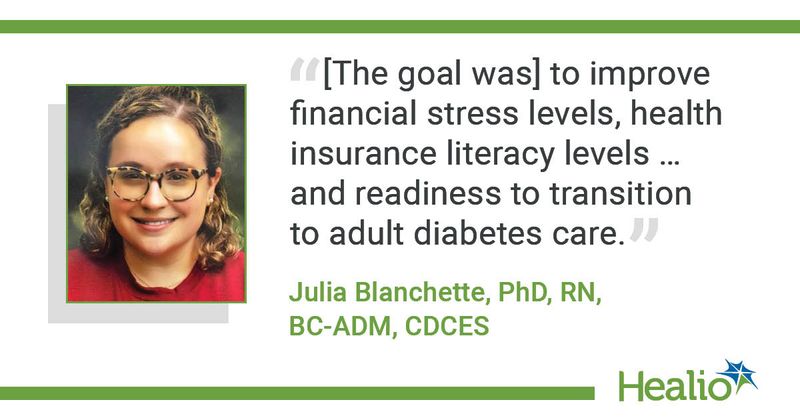Toolkit educates young adults with type 1 diabetes on navigating financial barriers
Young adults with type 1 diabetes said they gained knowledge about financial issues and health insurance after participating in a novel online educational program, according to study findings.
In a longitudinal randomized controlled trial, 20 young adults randomly assigned to have access to an online financial and health insurance education intervention called the T1D Financial Toolkit reported high satisfaction with the intervention and gratitude for the focus on barriers they faced with health finances and insurance, according to Julia Blanchette, PhD, RN, BC-ADM, CDCES, nurse scientist and diabetes care and education specialist at University Hospitals Cleveland Medical Center’s Center for Diabetes and Obesity, and clinical assistant professor of medicine at Case Western Reserve University in Cleveland.

“The T1D Financial Toolkit is an engaging, educational resource tailored to emerging adults with type 1 diabetes to aid in health insurance literacy and financial stress,” Blanchette told Healio. “In its pilot study, it was found to be feasible and acceptable. Future versions may be promising tools for diabetes clinicians to provide in practice or as part of the transition to adult diabetes care educational curriculum.”
Building the T1D Financial Toolkit
Blanchette and colleagues recruited 39 young adults aged 18 to 25 years with type 1 diabetes from an academic health science center in the Intermountain West (mean age, 22.76 years; 87.2% white). Participants were randomly assigned to an intervention group in which they would have access to the T1D Financial Toolkit (n = 20) or a control group without access to the toolkit (n = 19).
“The T1D Financial Toolkit is delivered in an online, asynchronous format and consists of 10 short videos that incorporate colorful graphics, closed captions and emerging adult peers living with type 1 diabetes,” Blanchette said. “The emerging adult peers are diverse and discuss personal experiences and stories to provide educational tips and information on finances and health insurance. The overarching goal was to develop a highly feasible and acceptable, engaging peer-led financial and health insurance intervention for young adults with type 1 diabetes and to improve financial stress levels, health insurance literacy levels, diabetes-related quality of life and readiness to transition to adult diabetes care.”
Semi-structured interviews were conducted by the research team at baseline, 1 month immediately after the intervention ended, and 3 months. The findings were published in The Science of Diabetes Self-Management and Care.
High satisfaction with the intervention
Of the cohort, 59% were employed full time, and 20.5% had an annual family income of less than $25,000. More than half of the participants were on their parents’ health insurance, and 76.9% had private, employer-sponsored health insurance. More than 70% used diabetes technology such as an insulin pump or continuous glucose monitor.
Participants in the intervention group had a favorable impression of the T1D Financial Toolkit videos, describing them as clean and easy to navigate. Participants said it was easy to integrate the time to watch the videos into their busy schedule. The majority of intervention participants discussed the video content and knowledge with others, and all participants said they gained knowledge about financial and health care system navigation.
All intervention participants reported being satisfied with the intervention. The majority reported finding the videos engaging and were satisfied with the graphic design and young adults with type 1 diabetes included in the videos. Three participants said they wanted extended access to help them through health insurance or financial barriers, and four said the videos educated them on new ways to problem-solve when facing those barriers.
“The toolkit had high acceptability overall with no significant recommendations to the content or toolkit structure,” Blanchette said. “However, a few participants indicated they would have benefited from receiving the resource at an earlier age or in a group setting with peers to allow for discussion of the toolkit video content and for the opportunity to apply critical thinking and problem-solving to real-life experiences. In the future, we hope to integrate the toolkit into group diabetes self-management transition education to maximize its impact.”
For more information:
Julia Blanchette, PhD, RN, BC-ADM, CDCES, can be reached at jeb195@case.edu.
